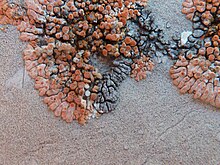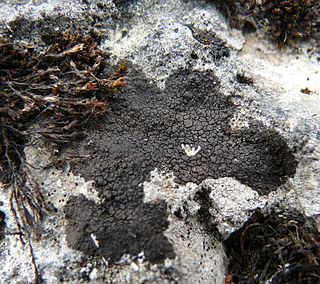
Verrucariaceae is a family of lichens and a few non-lichenised fungi in the order Verrucariales. The lichens have a wide variety of thallus forms, from crustose (crust-like) to foliose (bushy) and squamulose (scaly). Most of them grow on land, some in freshwater and a few in the sea. Many are free-living but there are some species that are parasites on other lichens, while one marine species always lives together with a leafy green alga.
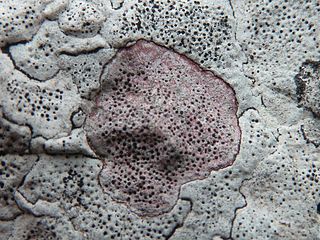
Bagliettoa is a genus of lichen-forming fungi in the family Verrucariaceae. The genus was circumscribed by Italian lichenologist Abramo Bartolommeo Massalongo in 1853. Bagliettoa species are endolithic, growing between the grains of solid rock.

Heteroplacidium is a genus of lichen-forming fungi in the family Verrucariaceae. The genus was circumscribed by Austrian lichenologist Othmar Breuss in 1996 with Heteroplacidium imbricatum assigned as the type species. It was proposed as a segregate of Catapyrenium. Other morphologically similar genera are Neocatapyrenium, Placidium, and Scleropyrenium, although molecular phylogenetic analyses indicate that they are independent monophyletic lineages within the Verrucariaceae.

Verrucaria is a genus of lichenized (lichen-forming) fungi in the family Verrucariaceae.
Xenothecium is a genus of fungus in the family Hyponectriaceae; according to the 2007 Outline of Ascomycota, the placement in this family was uncertain. In 2020 it was confirmed. This is a monotypic genus, its only species being Xenothecium jodophilum. It was published by Franz Xaver Rudolf von Höhnel in Sber. Akad. Wiss. Wien, Math.-naturw. Kl., Abt. 1 vol.128 (7-8) on page 589 in 1919.
Sarcopyrenia is a genus of lichenicolous (lichen-dwelling) fungi. It has 11 species. It is the only genus in Sarcopyreniaceae, a family in the order Verrucariales. Sarcopyrenia was circumscribed by Finnish lichenologist William Nylander in 1858, with Sarcopyrenia gibba assigned as the type species. Sarcopyreniaceae is one of the few families composed entirely of lichenicolous fungi.
Unguiculella is a genus of lichen-forming fungi in the family Cordieritidaceae. A total of 17 species fall under this genus.
Lambertella is a genus of fungi in the family Rutstroemiaceae.

Flavoplaca is a genus of crust-like or scaly lichens in the family Teloschistaceae. It has 28 species with a mostly Northern Hemisphere distribution.

Hydropunctaria is a genus of saxicolous (rock-dwelling), crustose lichens in the family Verrucariaceae. The genus includes both aquatic and amphibious species, with members that colonise either marine or freshwater habitats. The type species, Hydropunctaria maura, was formerly classified in the large genus Verrucaria. It is a widely distributed species common to littoral zones. Including the type species, five Hydropunctaria lichens are considered marine species: H. adriatica, H. amphibia, H. aractina, H. orae, and H. oceanica.
Heteroplacidium zamenhofianum is a species of lichenicolous (lichen-eating) lichen in the family Verrucariaceae. As a juvenile, it is parasitic on some members of the lichen genus Staurothele, but later becomes independent and develops a brown, crustose thallus. Characteristic features of the lichen include its dark brown, somewhat squamulous thallus and relatively small ascospores. It is widely distributed in Europe and North America.

Verruculopsis is a genus of saxicolous (rock-dwelling), crustose lichens in the family Verrucariaceae. It was circumscribed in 2007 by Cécile Gueidan, Pere Navarro-Rosinés, and Claude Roux, with Verruculopsis poeltiana assigned as the type species.
Halospora is a genus of lichenicolous (lichen-dwelling) fungi in the family Verrucariaceae. Species in the genus parasitise calcicolous crustose lichens, i.e., those that prefer lime-rich substrates.
Hydropunctaria rheitrophila is a species of freshwater, saxicolous (rock-dwelling), crustose lichen in the family Verrucariaceae. It was formally described as a new species in 1922 by German lichenologist Georg Hermann Zschacke as a species of Verrucaria. Christine Keller, Cécile Gueidan, and Holger Thüs transferred it to the newly circumscribed genus Hydropunctaria in 2009. It is one of several aquatic lichens that are in this genus. The photobiont partner of Hydropunctaria rheitrophila is a yellow-green alga.
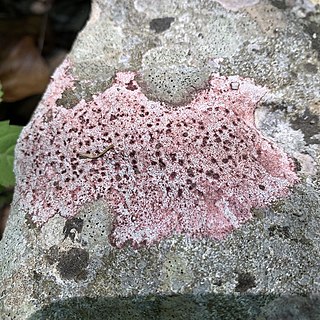
Bagliettoa marmorea is a species of saxicolous (rock-dwelling), crustose lichen in the family Verrucariaceae. It is endolithic on calcareous rocks, meaning it grows under and around the rock crystals. The colour of the lichen is purple to pink, although sometimes it is grey with purple pigments visible only around the perithecia. It does not have a shield-shaped involucrellum, which is typical of several other species in genus Bagliettoa. The excipulum measures 0.2–0.3 mm in diameter and lacks colour other than the upper part, which is purple. Ascospores are 13–30 by 9–15 μm.
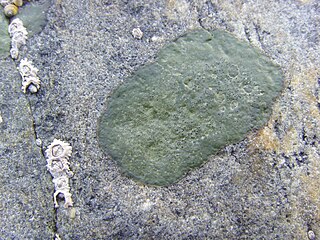
Wahlenbergiella mucosa is a species of saxicolous (rock-dwelling), crustose lichen in the family Verrucariaceae. It is a marine species that grows in the littoral zone, and therefore remains immersed in seawater for extended periods. Its photobiont partner is the green alga Paulbroadya petersii.
Ferdinand Joseph Georges Alexandre Clauzade was a French botanist and lichenologist. His specialty was the lichen flora of France and the Mediterranean region.
Wahlenbergiella tavaresiae is a species of saxicolous (rock-dwelling), crustose lichen in the family Verrucariaceae. Known from several locations in the San Francisco Bay area of the United States, it is a marine lichen that inhabits intertidal zones, and as such is immersed in seawater on a regular basis. Associated algal species include the red algae Hildenbrandia and Mastocarpus papillatus, and the brown algae Pelvetiopsis and Fucus. Petroderma maculiforme, a brown alga, is the photobiont partner in the lichen.
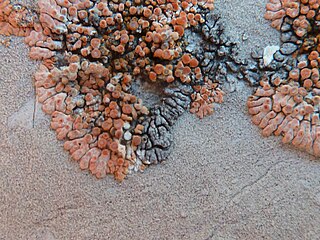
Verrucula arnoldaria is a rare species of lichenicolous (lichen-dwelling) lichen in the family Verrucariaceae. It grows parasitically on the thallus of the rock-dwelling, crustose lichen Calogaya arnoldii. The species was formally described as new to science in 2007 by lichenologists Père Navarro-Rosinés and Claude Roux, from specimens collected in Vaucluse, France. It has also been recorded from Italy. The lichen has a thick brownish-grey, areolate thallus that roughly maintains the shape of its underlying host. The thallus is covered with a crystalline pruina. It makes ellipsoid spores that measure up to about 15 μm long. Its host grows on calciferous rocks and calciferous schists.
